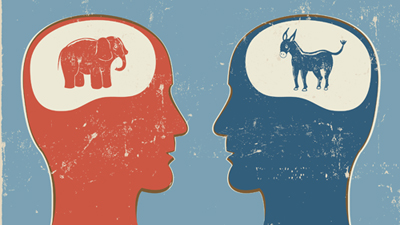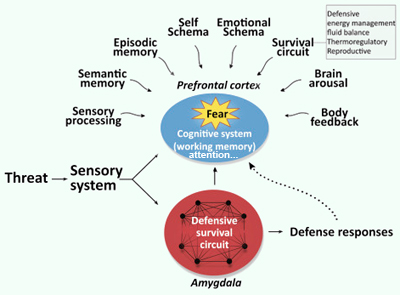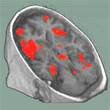Wednesday, 14 November 2018
Political Allegiance and Brain Biology
 How hard it is to get someone to shift their allegiance from one political party to another is something that many of us know from personal experience, but it has also been demonstrated experimentally. For example, in subjects who were exposed to political ideas opposed to their own, researchers have recorded brain activity similar to that associated with the processing of pain or negative emotions. Conversely, when subjects were asked to justify their own political positions, their ventral striatum became more active, the typical sign of a pleasant, positive experience—in short, a reward.
How hard it is to get someone to shift their allegiance from one political party to another is something that many of us know from personal experience, but it has also been demonstrated experimentally. For example, in subjects who were exposed to political ideas opposed to their own, researchers have recorded brain activity similar to that associated with the processing of pain or negative emotions. Conversely, when subjects were asked to justify their own political positions, their ventral striatum became more active, the typical sign of a pleasant, positive experience—in short, a reward.
So does this mean that all of us are stuck in a self-referential loop that would significantly compromise the possibility of any genuine political debate? (more…)
Emotions and the Brain | No comments
Tuesday, 21 November 2017
Conceptual evolution in some explanations in neuroscience

This website and this blog have been around long enough now (over 15 years and nearly 7 years, respectively) to have witnessed the ongoing evolution and refinement of certain concepts in the neurosciences. We all know that science evolves, but it can be interesting to see how. That’s what I’d like to show today, using an example of conceptual evolution. This example relates to the amygdalae—the two almond-shaped groups of neuronal nuclei on either side of the brain that were associated with human fear reactions very early in the history of neuroscience. Indeed, studies such as those by Joseph LeDoux have shown that when a threatening stimulus is presented to rats or humans, the neurons in each amygdala in their brains become highly active.
But as brain-imaging studies became more common, they showed that the activity in someone’s amygdala could also increase in other situations as well (for example, when that person was extremely hungry or saw a loved one suffering). (more…)
Emotions and the Brain | No comments
Tuesday, 6 August 2013
“Centres” of Cognitive Functions in the Brain: A Misleading Concept

The media nowadays often publish reports that scientists using brain-imaging technology have just discovered the brain’s “centre” for anger, jealousy, generosity, or some other specific emotion or cognitive function. But the idea of such a centre is, at best, an outrageous oversimplification, and at worst, completely misleading.
That is the argument made by Dr. William A. Cunningham in the February 2012 issue of the journal Current Directions in Psychological Science. His article deconstructs a very limited view of a part of the brain called the amygdala,which the popular press often describes as the brain’s “fear centre”. (more…)
Emotions and the Brain | 1 comment
Monday, 21 January 2013
When Fear Makes Us React Conservatively
 Paul Nail and his colleagues at the University of Central Arkansas conducted a series of three experiments that showed how a psychologically threatening situation can make someone whose thinking is usually liberal adopt a more conservative position. The adjectives “liberal” and “conservative” should be understood here in their general sense, where the former describes an attitude favouring openness, empathy, communication, and social justice, while the latter emphasizes tradition, order, authority, and discipline. (more…)
Paul Nail and his colleagues at the University of Central Arkansas conducted a series of three experiments that showed how a psychologically threatening situation can make someone whose thinking is usually liberal adopt a more conservative position. The adjectives “liberal” and “conservative” should be understood here in their general sense, where the former describes an attitude favouring openness, empathy, communication, and social justice, while the latter emphasizes tradition, order, authority, and discipline. (more…)
Emotions and the Brain | Comments Closed







